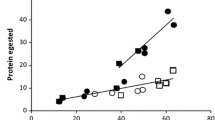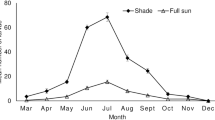Abstract
Ecologists have long been interested in how the nutritional composition of leaves changes as they age, and whether this affects herbivore feeding preferences. As a consequence, the literature abounds with reports that younger leaves contain higher concentrations of nitrogen and plant secondary metabolites (PSMs) than do older leaves. Most of these studies, however, base their conclusions on average values that often mean little to herbivores. We examined this issue in the well-studied marsupial-eucalypt system, using Eucalyptus melliodora and captive common brushtail possums (Trichosurus vulpecula) offered branches from individual trees containing both young and mature leaves. Like many plants, the concentrations of N and PSMs differed among individual E. melliodora. Although young leaves were, on average, “better defended” by the PSM sideroxylonal than were mature leaves, some trees produced leaves that were relatively undefended at both ages. In response, possums chose different proportions of young and mature leaves depending on the chemistry of the individual tree. Possums did not always prefer leaves with lower concentrations of sideroxylonal (mature leaves) or those with higher concentrations of available N (young leaves). Instead, the sideroxylonal concentration of young leaves dictated their choice: possums preferred young leaves with low sideroxylonal concentrations, but not with high concentrations. By skewing their feeding toward trees producing young leaves with low concentrations of PSMs, possums may influence plant fitness. Researchers will detect these potentially important interactions only if they are aware that measuring variation among plants discloses more information than do average relationships.





Similar content being viewed by others
References
Andrew RL, Peakall R, Wallis IR, Wood JT, Knight EJ, Foley WJ (2005) Marker-based quantitative genetics in the wild?: the heritability and genetic correlation of chemical defenses in Eucalyptus. Genetics 171:1989–1998. https://doi.org/10.1534/genetics.105.042952
Andrew RL, Wallis IR, Harwood CE, Henson M, Foley WJ (2007) Heritable variation in the foliar secondary metabolite sideroxylonal in Eucalyptus confers cross-resistance to herbivores. Oecologia 153:891–901. https://doi.org/10.1007/s00442-007-0784-1
Au J, Marsh KJ, Wallis IR, Foley WJ (2013) Whole-body protein turnover reveals the cost of detoxification of secondary metabolites in a vertebrate browser. J Comp Physiol B 183:993–1003. https://doi.org/10.1007/s00360-013-0754-3
Behmer ST, Simpson SJ, Raubenheimer D (2002) Herbivore foraging in chemically heterogeneous environments: nutrients and secondary metabolites. Ecology 83:2489–2501. https://doi.org/10.2307/3071809
Center TD, Wright AD (1991) Age and phytochemical composition of water hyacinth (Pontederiaceae) leaves determine their acceptability to Neochetina eichhorniae (Coleoptera: Curculionidae). Environ Entomol 20:323–334
DeGabriel JL, Wallis IR, Moore BD, Foley WJ (2008) A simple, integrative assay to quantify nutritional quality of browses for herbivores. Oecologia 156:107–116
DeGabriel JL, Moore BD, Foley WJ, Johnson CN (2009) The effects of plant defensive chemistry on nutrient availability predict reproductive success in a mammal. Ecology 90:711–719
DeGabriel JL, Moore BD, Marsh KJ, Foley WJ (2010) The effect of plant secondary metabolites on the interplay between the internal and external environments of marsupial folivores. Chemoecology 20:97–108. https://doi.org/10.1007/s00049-009-0037-3
Degabriele R (1981) A relative shortage of nitrogenous food in the ecology of the koala (Phascolarctos cinereus). Aust J Ecol 6:139–141
Felton AM, Felton A, Raubenheimer D, Simpson SJ, Foley WJ, Wood JT, Wallis IR, Lindenmayer DB (2009) Protein content of diets dictates the daily energy intake of a free-ranging primate. Behav Ecol 20:685–690. https://doi.org/10.1093/beheco/arp021
Freeland WJ, Winter JW (1975) Evolutionary consequences of eating: Trichosurus vulpecula (Marsupialia) and the genus Eucalyptus. J Chem Ecol 1:439–455
Gutbrodt B, Dorn S, Unsicker SB, Mody K (2012) Species-specific responses of herbivores to within-plant and environmentally mediated between-plant variability in plant chemistry. Chemoecology 22:101–111. https://doi.org/10.1007/s00049-012-0102-1
Henery ML, Wallis IR, Stone C, Foley WJ (2008) Methyl jasmonate does not induce changes in Eucalyptus grandis leaves that alter the effect of constitutive defences on larvae of a specialist herbivore. Oecologia 156:847–859. https://doi.org/10.1007/s00442-008-1042-x
Hume ID, Bladon RV, Soran N (1996) Seasonal changes in digestive performance of common ringtail possums (Pseudocheirus peregrinus) fed Eucalyptus foliage. Aust J Zool 44:327–336. https://doi.org/10.1071/Zo9960327
Jensen LM, Wallis IR, Marsh KJ, Moore BD, Wiggins NL, Foley WJ (2014) Four species of arboreal folivore show differential tolerance to a secondary metabolite. Oecologia 176:251–258. https://doi.org/10.1007/s00442-014-2997-4
Kavanagh RP, Lambert MJ (1990) Food selection by the greater glider, Petauroides volans - is foliar nitrogen a determinant of habitat quality. Aust Wildlife Res 17:285–299
Krockenberger AK, Hume ID, Cork SJ (1998) Production of milk and nutrition of the dependent young of free-ranging koalas (Phascolarctos cinereus). Physiol Zool 71:45–56
Lambdon PW, Hassall M (2005) How should toxic secondary metabolites be distributed between the leaves of a fast-growing plant to minimize the impact of herbivory? Funct Ecol 19:299–305. https://doi.org/10.1111/j.0269-8463.2005.00966.x
Landsberg JJ, Cork SJ (1997) Herbivory: interactions between eucalypts and the vertebrates and invertebrates that feed on them. In: Williams JE, Woinarski JCZ (eds) Eucalypt ecology: individuals to ecosystems. Cambridge University Press, Cambridge, pp 342–372
Lawler IR, Foley WJ, Pass GJ, Eschler BM (1998) Administration of a 5HT3 receptor antagonist increases the intake of diets containing Eucalyptus secondary metabolites by marsupials. J Comp Physiol B 168:611–618. https://doi.org/10.1007/s003600050183
Mangione AM, Dearing MD, Karasov WH (2000) Interpopulation differences in tolerance to creosote bush resin in desert woodrats (Neotoma lepida). Ecology 81:2067–2076. https://doi.org/10.1890/0012-9658(2000)081[2067:Idittc]2.0.Co;2
Marsh KJ, Foley WJ, Cowling A, Wallis IR (2003) Differential susceptibility to Eucalyptus secondary compounds explains feeding by the common ringtail (Pseudocheirus peregrinus) and common brushtail possum (Trichosurus vulpecula). J Comp Physiol B 173:69–78
Marsh KJ, Wallis IR, Andrew RL, Foley WJ (2006) The detoxification limitation hypothesis: where did it come from and where is it going? J Chem Ecol 32:1247–1266. https://doi.org/10.1007/s10886-006-9082-3
Marsh KJ, Moore BD, Wallis IR, Foley WJ (2014) Feeding rates of a mammalian browser confirm the predictions of a 'foodscape' model of Its habitat. Oecologia 174:873–882. https://doi.org/10.1007/s00442-013-2808-3
Matsuki M, Foley WJ, Floyd RB (2011) Role of volatile and non-volatile plant secondary metabolites in host tree selection by Christmas beetles. J Chem Ecol 37:286–300. https://doi.org/10.1007/s10886-011-9916-5
McCall AC, Fordyce JA (2010) Can optimal defence theory be used to predict the distribution of plant chemical defences? J Ecol 98:985–992. https://doi.org/10.1111/j.1365-2745.2010.01693.x
McKey D (1979) The distribution of secondary compounds within plants. In: Rosenthal G, Janzen D (eds) Herbivores: their interaction with secondary plant metabolites, first edn. Academic Press, New York, pp 55–133
Moore BD, Foley WJ (2000) A review of feeding and diet selection in koalas (Phascolarctos cinereus). Aust J Zool 48:317–333. https://doi.org/10.1071/Zo99034
Moore BD, Lawler IR, Wallis IR, Beale CM, Foley WJ (2010) Palatability mapping: a koala's eye view of spatial variation in habitat quality. Ecology 91:3165–3176. https://doi.org/10.1890/09-1714.1
Nersesian CL, Banks PB, Simpson SJ, McArthur C (2012) Mixing nutrients mitigates the intake constraints of a plant toxin in a generalist herbivore. Behav Ecol 23:879–888
Padovan A, Lanfear R, Keszei A, Foley WJ, Kulheim C (2013) Differences in gene expression within a striking phenotypic mosaic Eucalyptus tree that varies in susceptibility to herbivory. BMC Plant Biol 13:29. https://doi.org/10.1186/1471-2229-13-29
Padovan A, Patel HR, Chuah A, Huttley GA, Krause ST, Degenhardt J, Foley WJ, Kulheim C (2015) Transcriptome sequencing of two phenotypic mosaic Eucalyptus trees reveals large scale transcriptome re-modelling. PLoS One 10:e0123226. https://doi.org/10.1371/journal.pone.0123226
Pahl LI (1987) Feeding behavior and diet of the common ringtail possum, Pseudocheirus peregrinus, in Eucalyptus woodlands and Leptospermum thickets in southern Victoria. Aust J Zool 35:487–506. https://doi.org/10.1071/Zo9870487
Pfister JA, Provenza FD, Manners GD, Gardner DR, Ralphs MH (1997) Tall larkspur ingestion: can cattle regulate intake below toxic levels? J Chem Ecol 23:759–777. https://doi.org/10.1023/B:Joec.0000006409.20279.59
Raubenheimer D, Simpson SJ (1993) The geometry of compensatory feeding in the locust. Anim Behav 45:953–964. https://doi.org/10.1006/anbe.1993.1114
Rhoades D (1979) Evolution of plant chemical defenses against herbivores. In: Rosenthal GA, Janzen DH (eds) Herbivores: their interaction with secondary plant metabolites, first edn. Academic Press, New York, pp 1–54
Stapley J, Foley WJ, Cunningham R, Eschler B (2000) How well can common brushtail possums regulate their intake of Eucalyptus toxins? J Comp Physiol B 170:211–218. https://doi.org/10.1007/s003600050277
Utsumi SA, Cibils AF, Estell RE, Soto-Navarro SA, Van Leeuwen D (2009) Seasonal changes in one seed juniper intake by sheep and goats in relation to dietary protein and plant secondary metabolites. Small Rumin Res 81:152–162. https://doi.org/10.1016/j.smallrumres.2008.12.011
Villalba JJ, Provenza FD (2005) Foraging in chemically diverse environments: energy, protein, and alternative foods influence ingestion of plant secondary metabolites by lambs. J Chem Ecol 31:123–138. https://doi.org/10.1007/s10886-005-0979-z
Villalba JJ, Provenza FD, Banner RE (2002) Influence of macronutrients and activated charcoal on intake of sagebrush by sheep and goats. J Anim Sci 80:2099–2109
Villalba JJ, Burritt EA, St Clair SB (2014) Aspen (Populus tremuloides Michx.) intake and preference by mammalian herbivores: the role of plant secondary compounds and nutritional context. J Chem Ecol 40:1135–1145. https://doi.org/10.1007/s10886-014-0507-0
Vourc'h G, Russell J, Martin JL (2002) Linking deer browsing and terpene production among genetic identities in Chamaecyparis nootkatensis and Thuja plicata (Cupressaceae). J Hered 93:370–376. https://doi.org/10.1093/jhered/93.5.370
Wallis IR, Foley WJ (2005) The rapid determination of sideroxylonals in Eucalyptus foliage by extraction with sonication followed by HPLC. Phytochem Anal 16:49–54. https://doi.org/10.1002/Pca.810
Wallis IR, Watson ML, Foley WJ (2002) Secondary metabolites in Eucalyptus melliodora: field distribution and laboratory feeding choices by a generalist herbivore, the common brushtail possum. Aust J Zool 50:507–519. https://doi.org/10.1071/ZO02029
Wang J, Provenza FD (1997) Dynamics of preference by sheep offered foods varying in flavors, nutrients, and a toxin. J Chem Ecol 23:275–288. https://doi.org/10.1023/B:Joec.0000006359.62931.F9
Acknowledgements
We thank Jessie Au for conducting some of the HPLC analyses. Pauline Ding from the Australian National University Statistical Consulting Unit gave statistical advice. Animal work was approved by the Australian National University Animal Experimentation Ethics Committee and conforms to the Australian Code of Practice for the Care and Use of Animals for Scientific Purposes.
Funding
The study was supported by funding from the Australian Research Council to KJM (DE120101263).
Author information
Authors and Affiliations
Corresponding author
Ethics declarations
Conflict of Interest
The authors declare that they have no conflict of interest.
Rights and permissions
About this article
Cite this article
Marsh, K.J., Ward, J., Wallis, I.R. et al. Intraspecific Variation in Nutritional Composition Affects the Leaf Age Preferences of a Mammalian Herbivore. J Chem Ecol 44, 62–71 (2018). https://doi.org/10.1007/s10886-017-0911-3
Received:
Revised:
Accepted:
Published:
Issue Date:
DOI: https://doi.org/10.1007/s10886-017-0911-3




